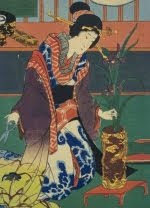
Land Art and ikebana both acquires studying nature. It has been said that while ikebana is inspired by nature Land Art works nature. I'd say the difference is not that obvious anymore since modern ikebana has moved quite a bit in the direction of sculpture and Land Art.
A few years ago
Stichting Kunstboek published a series of three photo books with ikebana arrangements by contemporary ikebana artists around the world. The second book titled
Contemporary Ikebana (2008) presented group work with an emphasis on Land Art projects.
In the preface Mit Ingelaere-Brandt, Sogestu ikebana teacher from Belgium, elaborates on the relation between Land Art and ikebana, stating that change and the interaction between the work and its surroundings are essential aspects in the experience of landscape art. This requires studying nature very carefully with an observance similar to that of the ikebana artist.
"The freedom of expression and monumentality so typical for Land Art, and the disciplined delicacy of traditional ikebana, go hand in hand. By making very subtle changes in the surrounding nature, by accentuating, adding and taking away small elements, the character of the work is often changed and the impact of the piece can be altered dramatically. Shifting emphasis and minimal adjustments in the landscape manage to catch, for an instant, the ever wandering eye of the beholder. In this way ikebana leads to deeper, more spiritual and contemplative consideration and understanding of nature and life in general."
The book
Contemporary Ikebana can roughly be divided in large–scale Land art compositions and smaller installations. It contents 200 photographs of nearly sixty Ikebana groups of thirteen nationalities. It's a heavy coffee table book with nice photos and many inspiring works. The book can still be bought from
Amazon. Note that the US edition has a different front cover.
ISBN: 9789058562692, ISBN-13: 9789058562692



















